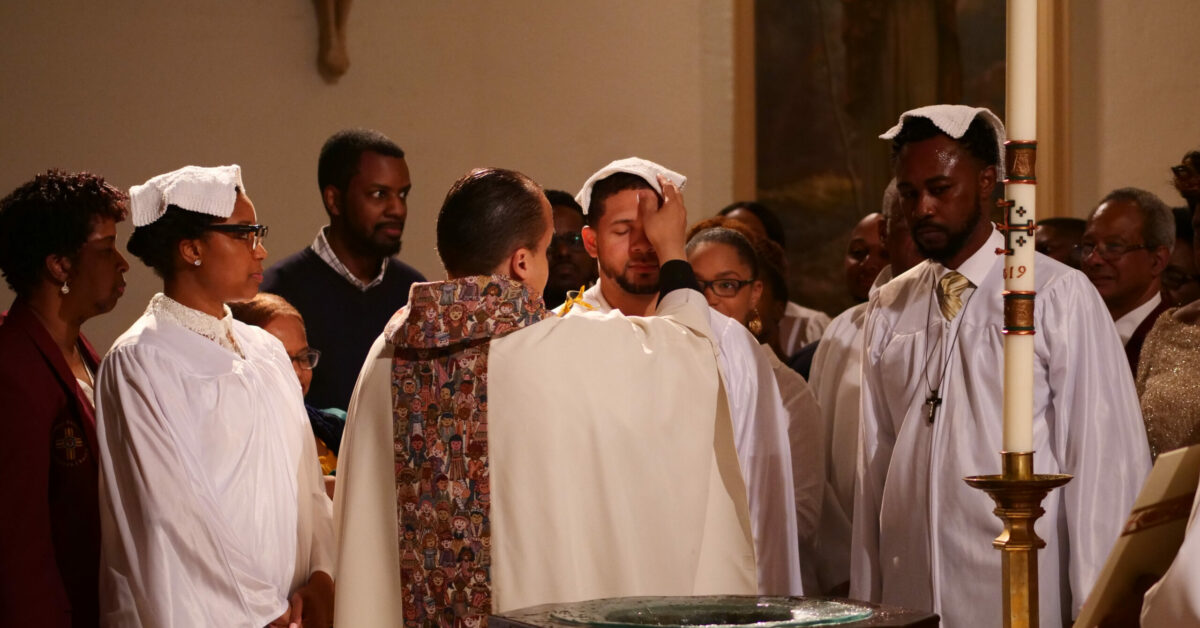Images of Baptism: Sacrament and Seal of the Holy Spirit
In our last post Rhoda concluded by highlighting the two primary biblical images of baptism: the tomb and the womb. Permeating those two primary images is the gift of the Holy Spirit. The gift of the Spirit is a thread through all of the images of baptism because as Maxwell Johnson says, “the one great and single mystery of our Christian faith” is the “unitive nature of Jesus’ death and resurrection and [the] gift of the Holy Spirit” (Images of Baptism, 73). Yet, as a thread through all of the images of baptism we can lose sight of the Spirit as gift and of the Spirit’s work. This happened in ritual history with the dissolution in the removal of baptismal sealing (anointing) from baptism itself and the creation of the distinct sacrament/rite of growth, confirmation. So, we must focus on the gift as a seal of the Holy Spirit as a distinct image of baptism. Paul himself does this in Ephesians when he says, “In him you also, when you heard the word of truth, the gospel of your salvation, and believed in him, were sealed with the promised Holy Spirit, who is the guarantee of our inheritance until we acquire possession of it, to the praise of his glory” (Ephesians 1:13-14). The Holy Spirit is poured out on the disciples of Christ Jesus abundantly through baptism. It seals us in the Holy Spirit who both fills and surrounds our living as children of God. The intent is that that seal is both complete and enduring into the kingdom of God. As Johnson says,
“It is the Holy Spirit, the very breath of God in us, who conforms us to the dying and rising of Christ in our lives, who brings us to new birth and regenerates us to new life in the living waters and womb of the font, who seals us in down payment for redemption, who gives us special charisms and gifts for the building up of and living within Christ’s body, the church, the Spirit of God who directs us in our mission of reconciling love, forgiveness and justice in the world, the Spirit alone who makes it possible for us to say, “We believe” or “I believe” in the first place” (Images of Baptism, 74-75).
The Holy Spirit is sent by Christ as our anointing in Him in baptism so that we might live at the direction of the Spirit.
It is that anointing in baptism by the Holy Spirit that is symbolized and expressed through the postbaptismal anointings in the western tradition. Historically the West has had a presbyteral anointing and an episcopal anointing. Whether we are talking about both as independent ritual actions or a combination of them, they both express that through the Word in the water the person is anointed with the Holy Spirit. As Johnson says, the baptismal water and the Spirit go together inseparably (80). “It is the presence and gift of the Holy Spirit that makes all the difference in the world in terms of baptism’s meaning and significance. Christian baptism is ‘baptism with the Holy Spirit!’” (Images of Baptism, 80).
This should have significant implications for our practice of baptism and of the catechumenate. As Johnson shows through the New Testament witness and as an implication of the anointing of the Spirit, all baptismal life in Christ is directed by the Spirit. If the Spirit is poured out in baptism, then that should be ritually expressed by anointing in baptism. It should not be delayed to the rite of confirmation. Doing so deconstructs the reality that as Johnson says, “all life in Christ is dependent upon the presence and guidance of the Holy Spirit” (Images of Baptism, 82). Baptism as the gift of the Holy Spirit calls for the practice of post-baptismal anointing.
The practice of the catechumenate bears out the reality that all life in Christ is dependent upon the Spirit. In no way can the catechumenate be understood as some great Pelagian enterprise, as Johnson indicates (Images of Baptism, 88). “A clear baptismal spirituality places the emphasis where it should be: on God, the great author and initiator of salvation” (Images of Baptism, 88). Conversion through the catechumenal process, as Johnson notes, is grounded in the Spirit’s activity and “the Holy Spirit is active before, in and after baptism” (Images of Baptism, 89). The catechumenate is the ground for the Spirit’s activity through the Word. As Johnson indicates, “Baptism invites the gathered assembly to faith, trust, dependency and receptivity to the sheer gift of God’s baptismal grace. The minds and hearts of that assembly are to be continually directed back to the foundational realities of new birth and new life in the Spirit” (Images of Baptism, 91). That is exactly what the catechumenate does in all its fullness.
Baptism as the seal of the Holy Spirit is in the end about everything regarding Christian faith and life post Christ’s ascension. “Questions about faith, justification, spirituality, ecclesiology, eschatology and the meaning of the eucharist are ultimately always questions about the Holy Spirit and the Spirit’s role in forming people as believers in and disciples of Christ” (Images of Baptism, 102). Sounds very much like the catechumenate to me!
Banner photo: Post-baptismal anointing with chrism at Redeemer Evangelical Lutheran Church, The Bronx, New York.
